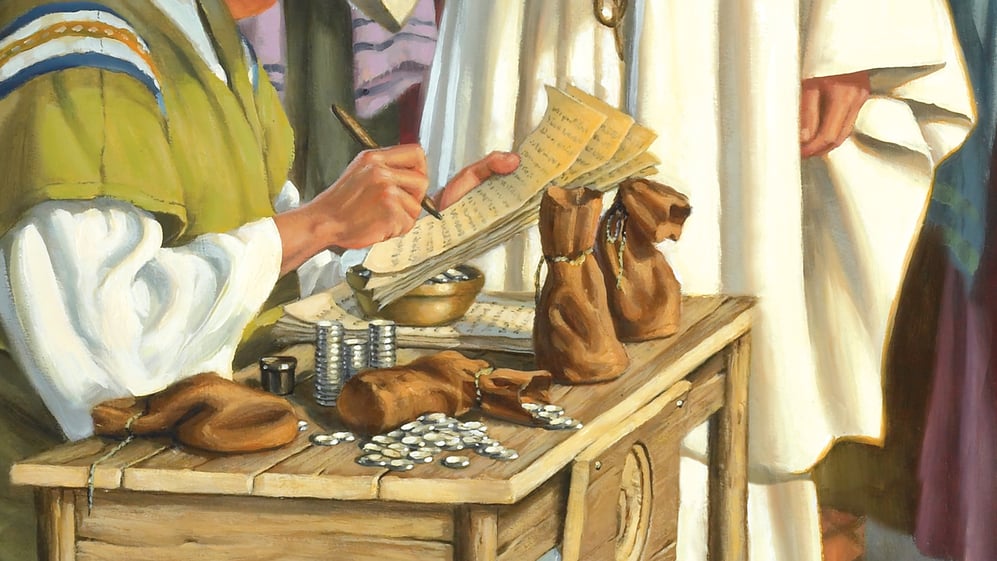This month, we learn a bit about Matthew, one of the Gospel writers. We begin with introductory key verses regarding his work and calling by Jesus, followed by teaching regarding the apostle, and finally, ideas for presenting Matthew in the Sunday School classroom.
Key Verses
Matthew 9:9
As Jesus passed on from there, He saw a man called Matthew sitting at the tax booth, and He said to him, “Follow me.” And he rose and followed Him.
Luke 18:11
The Pharisee, standing by himself, prayed thus: “God, I thank you that I am not like other men, extortioners, unjust, adulterers, or even like this tax collector.”
Mark 2:16
And the scribes of the Pharisees, when they saw that He was eating with sinners and tax collectors, said to His disciples, “Why does He eat with tax collectors and sinners?”
Luke 19:1–2
He entered Jericho and was passing through. And behold, there was a man named Zacchaeus. He was a chief tax collector and was rich.
What do we know about Matthew?
- He was a tax collector (Matthew 9:9).
- He was also named Levi (Mark 2:14).
- Matthew means “gift of Jehovah.”
- Levi means “joined to.”
- He was present when Matthias replaced Judas (Acts 1:13).
- He was one of the four Gospel writers.
- Only Matthew’s Gospel includes the visit of Wise Men (Matthew 2:1–12).
- Only Matthew’s Gospel records the guards’ report of Jesus’ resurrection. (Matthew 28:11–15).
- According to Christian tradition, Matthew is represented by a man with six wings and many eyes (Revelation 4:6–7).
Why is it important that Jesus called Matthew?
Remember that Rome ruled the people of Jesus’ day. In order to pay for the expenses of this empire, the Romans taxed people they conquered. Although in the United States, we use computers, forms, and tax agents to pay our taxes, the Roman system was somewhat simpler. The Romans understood that recruiting Jews to collect taxes from their own people would be most effective, since such men knew the language and customs.
As you might expect, tax collectors were not popular. The common people considered tax collectors to be traitors to their own people because they helped the tyrannical Romans bolster their wealth. What’s more, tax collectors were rumored to charge more taxes than the Romans demanded and then pocket the extra for themselves. The religious leaders of the day, like the Pharisees, considered tax collectors “unclean” because they associated with Gentiles. These leaders regarded these servants of Rome to be sinners along with criminals and prostitutes. Matthew was one such tax collector.
Nevertheless, Jesus calls Matthew to be one of His apostles. It’s significant that Matthew was not merely one of our Lord’s disciples, or students, but he was one of the Twelve. Matthew walked with Jesus constantly and participated in the major events of His ministry. What’s more, Jesus ate and drank with tax collectors like Matthew, enduring the mocking and rejection of others, including the religious leaders.
Matthew’s calling is an excellent opportunity to connect students to their own calling. Just as Jesus did not call Matthew because he was smarter, more skilled, or more holy than others, neither does the Lord choose us to serve Him because of who we are. Instead, just like Matthew, Jesus calls us because of His mercy, love, and desire to bless us with this service.
Secondly, there is a broader teaching opportunity. While the tax collectors were considered undesirables in biblical times, it’s important that students don’t apply this stigma to all such servants. Even in Matthew’s day, there were honest, hard-working tax collectors. Today, however we may feel about taxes, students should know that taxes are useful in a number of important ways: they pay for roads, police, fire departments, and the armed forces, just to name few. More importantly, even Jesus teaches, “Therefore render to Caesar the things that are Caesar's, and to God the things that are God's.”
Help students to understand why Jesus ate and drank with tax collectors and other sinners. He did not do so because He approved of their sins or because He loved them more than others. Jesus ate with sinners because He came to suffer die and rise again for all. What’s more, many who were called “sinners” understood their need to be forgiven more than those who condemned them did. In other words, the people who knew they were sinners were people who were ready to hear Jesus.
Teaching Ideas for Matthew
Who are the rejected in my life?
Ask students to list those in their life who are rejected or alone. Encourage them to consider every area: home, school. If students are older, include part-time jobs, sports teams, or those they know on social media. Lead them to explore how they could reach out to these people with the love of God and the message of salvation in Jesus.
Jesus is the “Sin Collector”
Prepare paper cutouts in the form of coins. Invite students to decorate these as they please. Additionally, have them write two or three sins on the coins. They could be sins they have committed, or more general sins. Prepare a box decorated with a cross and the words “Sin Collector”. Walk around and have students place their coins in the box. Explain that Jesus “collects” our sins and take them to the cross.
Scripture: ESV
Looking for more posts on teaching the twelve Apostles? Browse Pastor Rigdon’s other posts with the link below.














